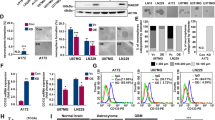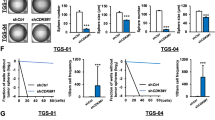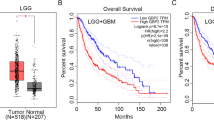Abstract
Glioblastoma (GBM) is the most common and fatal primary brain tumor in humans, and it is essential that new and better therapies are developed to treat this disease. Previous research suggests that casein kinase 2 (CK2) may be a promising therapeutic target for GBMs. CK2 has enhanced expression or activity in numerous cancers, including GBM, and it has been demonstrated that inhibitors of CK2 regressed tumor growth in GBM xenograft mouse models. Our studies demonstrate that the CK2 subunit, CK2α, is overexpressed in and has an important role in regulating brain tumor-initiating cells (BTIC) in GBM. Initial studies showed that two GBM cell lines (U87-MG and U138) transduced with CK2α had enhanced proliferation and anchorage-independent growth. Inhibition of CKα using siRNA or small-molecule inhibitors (TBBz, CX-4945) reduced cell growth, decreased tumor size, and increased survival rates in GBM xenograft mouse models. We also verified that inhibition of CK2α decreased the activity of a well-known GBM-initiating cell regulator, β-catenin. Loss of CK2α decreased two β-catenin-regulated genes that are involved in GBM-initiating cell growth, OCT4 and NANOG. To determine the importance of CK2α in GBM stem cell maintenance, we reduced CK2α activity in primary GBM samples and tumor spheres derived from GBM patients. We discovered that loss of CK2α activity reduced the sphere-forming capacity of BTIC and decreased numerous GBM stem cell markers, including CD133, CD90, CD49f and A2B5. Our study suggests that CK2α is involved in GBM tumorigenesis by maintaining BTIC through the regulation of β-catenin.
This is a preview of subscription content, access via your institution
Access options
Subscribe to this journal
Receive 50 print issues and online access
$259.00 per year
only $5.18 per issue
Buy this article
- Purchase on Springer Link
- Instant access to full article PDF
Prices may be subject to local taxes which are calculated during checkout








Similar content being viewed by others
References
Louis D, Ohgaki H, Wiestler O, W. Cavanee Glioblastoma. In: Louis D, Ohgaki H, Wiestler O, Cavanee W (eds). WHO Classification of Tumours of the Central NervousSystem. IARC Press: Paris, 1997, pp 33–49.
Stupp R, Mason WP, van den Bent MJ, Weller M, Fisher B, Taphoorn MJ et alRadiotherapy plus concomitant and adjuvant temozolomide for glioblastoma. N Engl J Med 2005; 352: 987–996.
Singh SK, Hawkins C, Clarke ID, Squire JA, Bayani J, Hide T et alIdentification of human brain tumour initiating cells. Nature 2004; 432: 396–401.
Bao S, Wu Q, McLendon RE, Hao Y, Shi Q, Hjelmeland AB et alGlioma stem cells promote radioresistance by preferential activation of the DNA damage response. Nature 2006; 444: 756–760.
Litchfield DW . Protein kinase CK2: structure, regulation and role in cellular decisions of life and death. Biochem J 2003; 369 (Pt 1): 1–15.
Trembley JH, Chen Z, Unger G, Slaton J, Kren BT, Van WC et alEmergence of protein kinase CK2 as a key target in cancer therapy. Biofactors 2010; 36: 187–195.
Prudent R, Moucadel V, Nguyen CH, Barette C, Schmidt F, Florent JC et alAntitumor activity of pyridocarbazole and benzopyridoindole derivatives that inhibit protein kinase CK2. Cancer Res 2010; 70: 9865–9874.
Moucadel V, Prudent R, Sautel CF, Teillet F, Barette C, Lafanechere L et alAntitumoral activity of allosteric inhibitors of protein kinase CK2. Oncotarget 2011; 2: 997–1010.
Olsen BB, Issinger OG, Guerra B . Regulation of DNA-dependent protein kinase by protein kinase CK2 in human glioblastoma cells. Oncogene 2010; 29: 6016–6026.
Zheng Y, McFarland BC, Drygin D, Yu H, Bellis SL, Kim H et alTargeting protein kinase CK2 suppresses pro-survival signaling pathways and growth of glioblastoma. Clin Cancer Res 2013; 19: 6484–6494.
Dixit D, Sharma V, Ghosh S, Mehta VS, Sen E . Inhibition of Casein kinase-2 induces p53-dependent cell cycle arrest and sensitizes glioblastoma cells to tumor necrosis factor (TNFalpha)-induced apoptosis through SIRT1 inhibition. Cell Death Dis 2012; 3: e271.
Cheong JW, Min YH, Eom JI, Kim SJ, Jeung HK, Kim JS . Inhibition of CK2{alpha} and PI3K/Akt synergistically induces apoptosis of CD34+CD38- leukaemia cells while sparing haematopoietic stem cells. Anticancer Res 2010; 30: 4625–4634.
Zhang S, Wang Y, Mao JH, Hsieh D, Kim IJ, Hu LM et alInhibition of CK2alpha down-regulates Hedgehog/Gli signaling leading to a reduction of a stem-like side population in human lung cancer cells. PLoS One 2012; 7: e38996.
Huillard E, Ziercher L, Blond O, Wong M, Deloulme JC, Souchelnytskyi S et alDisruption of CK2beta in embryonic neural stem cells compromises proliferation and oligodendrogenesis in the mouse telencephalon. Mol Cell Biol 2010; 30: 2737–2749.
Ji H, Wang J, Nika H, Hawke D, Keezer S, Ge Q et alEGF-induced ERK activation promotes CK2-mediated disassociation of alpha-Catenin from beta-Catenin and transactivation of beta-Catenin. Mol Cell 2009; 36: 547–559.
Ponce DP, Yefi R, Cabello P, Maturana JL, Niechi I, Silva E et alCK2 functionally interacts with AKT/PKB to promote the beta-catenin-dependent expression of survivin and enhance cell survival. Mol Cell Biochem 2011; 356: 127–132.
Ponce DP, Maturana JL, Cabello P, Yefi R, Niechi I, Silva E et alPhosphorylation of AKT/PKB by CK2 is necessary for the AKT-dependent up-regulation of beta-catenin transcriptional activity. J Cell Physiol 2011; 226: 1953–1959.
Murat A, Migliavacca E, Gorlia T, Lambiv WL, Shay T, Hamou MF et alStem cell-related "self-renewal" signature and high epidermal growth factor receptor expression associated with resistance to concomitant chemoradiotherapy in glioblastoma. J Clin Oncol 2008; 26: 3015–3024.
Lee Y, Scheck AC, Cloughesy TF, Lai A, Dong J, Farooqi HK et alGene expression analysis of glioblastomas identifies the major molecular basis for the prognostic benefit of younger age. BMC Med Genomics 2008; 1: 52.
Prudent R, Sautel CF, Moucadel V, Laudet B, Filhol O, Cochet C . In vitro and in vivo assays of protein kinase CK2 activity. Methods Enzymol 2010; 485: 597–610.
Grigoryan T, Wend P, Klaus A, Birchmeier W . Deciphering the function of canonical Wnt signals in development and disease: conditional loss- and gain-of-function mutations of beta-catenin in mice. Genes Dev 2008; 22: 2308–2341.
Nager M, Bhardwaj D, Canti C, Medina L, Nogues P, Herreros J . beta-Catenin signalling in glioblastoma multiforme and glioma-initiating cells. Chemother Res Pract 2012; 2012: 192362.
Lee J, Kotliarova S, Kotliarov Y, Li A, Su Q, Donin NM et alTumor stem cells derived from glioblastomas cultured in bFGF and EGF more closely mirror the phenotype and genotype of primary tumors than do serum-cultured cell lines. Cancer Cell 2006; 9: 391–403.
Beier CP, Beier D . CD133 negative cancer stem cells in glioblastoma. Front Biosci (Elite Ed) 2011; 3: 701–710.
He J, Liu Y, Lubman DM . Targeting glioblastoma stem cells: cell surface markers. Curr Med Chem 2012; 19: 6050–6055.
Hu Y, Smyth GK . ELDA: extreme limiting dilution analysis for comparing depleted and enriched populations in stem cell and other assays. J Immunol Methods 2009; 347: 70–78.
D'Amour KA, Gage FH . Are somatic stem cells pluripotent or lineage-restricted? Nat Med 2002; 8: 213–214.
Singh SK, Clarke ID, Terasaki M, Bonn VE, Hawkins C, Squire J et alIdentification of a cancer stem cell in human brain tumors. Cancer Res 2003; 63: 5821–5828.
Dalerba P, Clarke MF . Cancer stem cells and tumor metastasis: first steps into uncharted territory. Cell Stem Cell 2007; 1: 241–242.
Reya T, Morrison SJ, Clarke MF, Weissman IL . Stem cells, cancer, and cancer stem cells. Nature 2001; 414: 105–111.
Ikushima H, Todo T, Ino Y, Takahashi M, Saito N, Miyazawa K et alGlioma-initiating cells retain their tumorigenicity through integration of the Sox axis and Oct4 protein. J Biol Chem 2011; 286: 41434–41441.
Zbinden M, Duquet A, Lorente-Trigos A, Ngwabyt SN, Borges I, Altaba A . NANOG regulates glioma stem cells and is essential in vivo acting in a cross-functional network with GLI1 and p53. EMBO J 2010; 29: 2659–2674.
Song DH, Dominguez I, Mizuno J, Kaut M, Mohr SC, Seldin DC . CK2 phosphorylation of the armadillo repeat region of beta-catenin potentiates Wnt signaling. J Biol Chem 2003; 278: 24018–24025.
Ponce DP, Yefi R, Cabello P, Maturana JL, Niechi I, Silva E et alCK2 functionally interacts with AKT/PKB to promote the beta-catenin-dependent expression of survivin and enhance cell survival. Mol Cell Biochem 2011; 356: 127–132.
Clement V, Sanchez P, de Tribolet N, Radovanovic I, Altaba A . HEDGEHOG-GLI1 signaling regulates human glioma growth, cancer stem cell self-renewal, and tumorigenicity. Curr Biol 2007; 17: 165–172.
Abdouh M, Facchino S, Chatoo W, Balasingam V, Ferreira J, Bernier G . BMI1 sustains human glioblastoma multiforme stem cell renewal. J Neurosci 2009; 29: 8884–8896.
Adesina AM, Lopez-Terrada D, Wong KK, Gunaratne P, Nguyen Y, Pulliam J et alGene expression profiling reveals signatures characterizing histologic subtypes of hepatoblastoma and global deregulation in cell growth and survival pathways. Hum Pathol 2009; 40: 843–853.
Molofsky AV, Pardal R, Iwashita T, Park IK, Clarke MF, Morrison SJ . Bmi-1 dependence distinguishes neural stem cell self-renewal from progenitor proliferation. Nature 2003; 425: 962–967.
Scharenberg CW, Harkey MA, Torok-Storb B . The ABCG2 transporter is an efficient Hoechst 33342 efflux pump and is preferentially expressed by immature human hematopoietic progenitors. Blood 2002; 99: 507–512.
Pierfelice TJ, Schreck KC, Eberhart CG, Gaiano N . Notch, neural stem cells, and brain tumors. Cold Spring Harb Symp Quant Biol 2008; 73: 367–375.
Fan X, Matsui W, Khaki L, Stearns D, Chun J, Li YM et alNotch pathway inhibition depletes stem-like cells and blocks engraftment in embryonal brain tumors. Cancer Res 2006; 66: 7445–7452.
Androutsellis-Theotokis A, Leker RR, Soldner F, Hoeppner DJ, Ravin R, Poser SW et alNotch signalling regulates stem cell numbers in vitro and in vivo. Nature 2006; 442: 823–826.
Zhang S, Long H, Yang YL, Wang Y, Hsieh D, Li W et alInhibition of CK2alpha down-regulates Notch1 signalling in lung cancer cells. J Cell Mol Med 2013; 17: 854–862.
Pagano MA, Bain J, Kazimierczuk Z, Sarno S, Ruzzene M, Di MG et alThe selectivity of inhibitors of protein kinase CK2: an update. Biochem J 2008; 415: 353–365.
Son YH, Song JS, Kim SH, Kim J . Pharmacokinetic characterization of CK2 inhibitor CX-4945. Arch Pharm Res 2013; 36: 840–845.
Nitta RT, Del Vecchio CA, Chu AH, Mitra SS, Godwin AK, Wong AJ . The role of the c-Jun N-terminal kinase 2-alpha-isoform in non-small cell lung carcinoma tumorigenesis. Oncogene 2011; 30: 234–244.
Nitta RT, Badal SS, Wong AJ . Measuring the constitutive activation of c-Jun N-terminal kinase isoforms. Methods Enzymol 2010; 484: 531–548.
Del Vecchio CA, Jensen KC, Nitta RT, Shain AH, Giacomini CP, Wong AJ . Epidermal growth factor receptor variant III contributes to cancer stem cell phenotypes in invasive breast carcinoma. Cancer Res 2012; 72: 2657–2671.
Acknowledgements
We thank Albert Wong for the use of equipment and resources. We also thank Tim Bui for his useful discussions and Cheryl Christensen for her critical review of the paper. This work was supported by the K08 Mentored Research Grant (NIH-KNS085333A) as well as the generous donation from Mr Keith Tsu and Ms Carmelita Ko.
Author information
Authors and Affiliations
Corresponding author
Ethics declarations
Competing interests
The authors declare no conflict of interest.
Additional information
Supplementary Information accompanies this paper on the Oncogene website
Rights and permissions
About this article
Cite this article
Nitta, R., Gholamin, S., Feroze, A. et al. Casein kinase 2α regulates glioblastoma brain tumor-initiating cell growth through the β-catenin pathway. Oncogene 34, 3688–3699 (2015). https://doi.org/10.1038/onc.2014.299
Received:
Revised:
Accepted:
Published:
Issue Date:
DOI: https://doi.org/10.1038/onc.2014.299
This article is cited by
-
Ovarian cancer G protein-coupled receptor 1 inhibits A549 cells migration through casein kinase 2α intronless gene and neutral endopeptidase
BMC Cancer (2022)
-
Simultaneous CK2/TNIK/DYRK1 inhibition by 108600 suppresses triple negative breast cancer stem cells and chemotherapy-resistant disease
Nature Communications (2021)
-
CD163, a novel therapeutic target, regulates the proliferation and stemness of glioma cells via casein kinase 2
Oncogene (2019)
-
Casein kinase 2 inhibition sensitizes medulloblastoma to temozolomide
Oncogene (2019)
-
Notch1 regulates the initiation of metastasis and self-renewal of Group 3 medulloblastoma
Nature Communications (2018)



